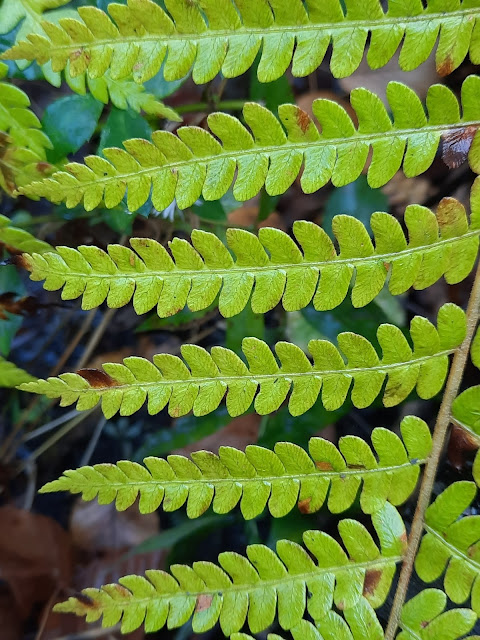Cinnamon Fern
A few weeks ago we shared a humbling tale of searching
for a cinnamon fern. This narrative demonstrates just a fraction of why this plant is so special and why we hope to
someday include it in the Museum's collections.
The Cinnamon Fern (Osmundastrum cinnamomeum) is a deciduous
fern that grows in wet areas and is among the first ferns to emerge in the
spring. It turns
orange, gold, or copper as the weather changes with autumn's cooler weather.
Classification - This fern is
a member of the Osmundaceae family, and so related to the Interrupted Fern and Royal Fern. Cinnamon Ferns, until
recently, were classified as Osmunda cinnamomea, and most older
guide books follow this classification, as does the US Department of Agriculture and Flora of North America. More recent DNA
evidence indicates that the Cinnamon Fern should be reclassified as Osmundastrum
cinnamomeum. The newer categorization has been adopted by the Integrated Taxonomic Information System (ITIS) and other databases.
Folklore - The common name (Cinnamon Fern) derives from the
cinnamon-brown color of the fertile fronds. The origin of the family name (Osmundaceae)
is unclear. The most popular theory is that it was originally derived from the
name Osmunder – the Saxon name for the Norse god Thor, who according to legend
hid his family from danger in a clump of these ferns.
Habitat - Cinnamon Ferns prefer wet soil, so look for it in wetland
habitats, including swamps and the edges of bogs. Cinnamon Ferns have pale cinnamon-colored wool tufts on the
underside of its sterile leaflets (pinnae), at the base near
the rachis (the stalk within the blade).
Identification - Like its relatives, the Cinnamon Fern
produces separate fertile and sterile fronds. The fertile fronds,
which are shorter, are the first to appear in the spring, initially as bright
green wands, then turning a deep cinnamon brown. The green,
arching sterile fronds are longer (20-60 inches). The pinnae (leaflets) on sterile fronds are large and narrow
gradually to the tip. The fiddleheads of Cinnamon Ferns are
covered with woolly white or reddish hairs.
Another clue to identifying the Cinnamon Fern is the fact that its
fertile fronds are very different from its sterile fronds – a characteristic
that it shares with Interrupted Ferns, Royal Ferns, and Sensitive Ferns. If you find a fern with two different types of
fronds growing on a moist or wet site, it may well be one of these ferns.
- The fertile fronds of Cinnamon Ferns appear in the center of the sterile fronds. Moreover, the Cinnamon Fern's fertile fronds lack the green pinnules characteristic of its two relatives.
- Interrupted Fern, by contrast, has fronds that are "interrupted" by two to five pairs of fertile pinnae in the midsection
- Royal Fern's fertile fronds has fertile pinnae at the end of the blade.
- The fertile blades of Sensitive Ferns have beadlike pinnae.
Ethnobotany - Cinnamon Ferns
have long been used as a food source, particularly by Native Americans,
including the Abnaki and Menominee. However, all parts of the plant (including
the fiddleheads) are now thought to be carcinogenic.
Cinnamon Ferns were used by a number of indigenous tribes for
medicinal purposes. A decoction of the root was reportedly rubbed into affected
joints to treat rheumatism. The plant was also used as a remedy for chills,
headache, joint pain, and colds. The
Iroquois have used a decoction for rheumatism and in a compound infusion for venereal
disease. Roots were used for “women’s
troubles.” The Cherokee are said to cook
the fronds for a spring tonic and combined the roots with Christmas fern for
rheumatism. The Menominee have used Cinnamon
Fern to promote the flow of milk and for caked breasts.

